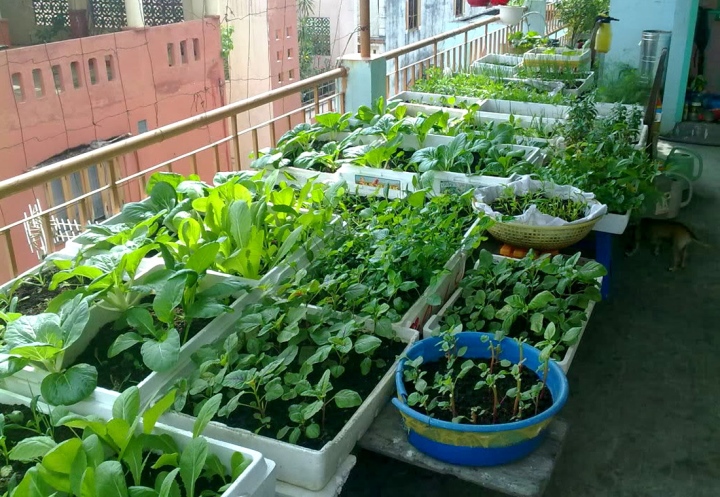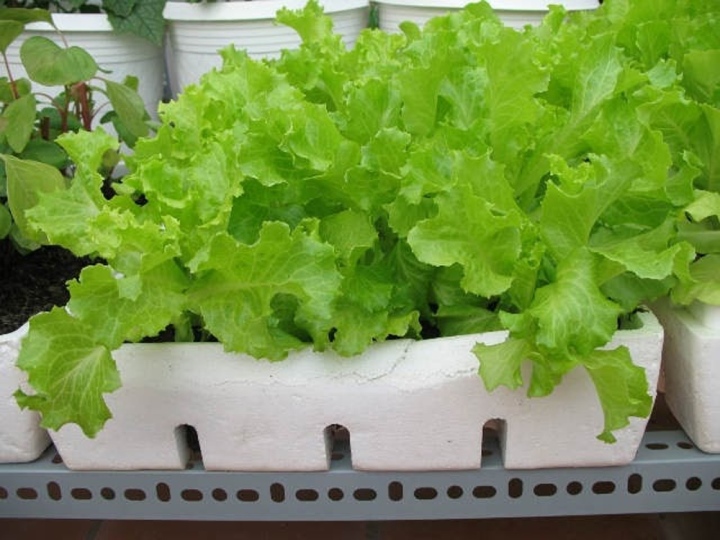That is the concern of many city residents when they want to grow vegetables and fruits to provide clean and safe meals for their families. By growing their own vegetables, people can proactively choose the seeds, soil, irrigation water, and fertilizers, meaning they can control the “inputs” of the plants. However, a question arises as to whether it is safe to grow vegetables in foam containers, as this is the most common and convenient container.
Is it safe to grow vegetables in foam containers?
The main material that makes up foam containers is Expand Polystyrene, which is formed when boiled and expanded at high temperatures to form foam particles. According to the analysis by Associate Professor Tran Hong Con (Faculty of Chemistry, Hanoi National University) on VnExpress, the material that makes up foam containers is primarily composed of air, accounting for 95%; the low molecular weight thermoplastic polystyrene is considered a safe material. These materials only undergo changes at very high temperatures, around 180-200 degrees Celsius. This means that the foam material only becomes harmful to health when it is burned.
In reality, even on the hottest summer days, the temperature on balconies or rooftop gardens usually does not exceed 50-60 degrees Celsius. Therefore, growing vegetables in foam containers does not harm health or compromise the safety of the plants.

Many urban residents wonder if it is safe to grow vegetables in foam containers.
Supporting the same opinion, Assoc. Prof. Dr. Nguyen Duy Thinh, Institute of Biotechnology and Food Technology, Hanoi University of Technology, said that foam containers are not a factor that compromises the safety of growing vegetables. The important thing is to use clean soil and clean water. If you plant using polluted soil and water, harmful substances (such as sulfur, mercury, lead, etc.) can adhere to the vegetable stalks. This is not to mention the various parasites in dirty soil that can make the vegetables you grow unsafe.
According to Assoc. Prof. Dr. Nguyen Duy Thinh, people can feel completely at ease growing vegetables in foam containers, wooden containers, or ceramic pots… but they need to control and ensure the cleanliness of the planting soil and irrigation water. In addition, it is also important to avoid letting soil or planting substrate fall out, which can compromise hygiene and pollute the living environment, or using water containers as ideal breeding grounds for mosquitoes, creating a risk of dengue fever.
What should be noted when growing vegetables in foam containers?
Once you are no longer worried about whether it is safe to grow vegetables in foam containers, you can start learning about the steps to grow vegetables in foam containers and the precautions to increase the effectiveness of farming.
Step 1: Preparation
Prepare the foam container: Depending on the space available for growing vegetables, choose a suitable size for the foam container, as long as it reaches a minimum height of 30cm. The deeper the container, the more soil it can hold, which helps the vegetables develop better.
Prepare the seeds: Instead of randomly selecting seeds to plant, you should choose seeds of vegetable varieties that are suitable for the local climate and weather conditions to ensure healthy plant growth and reduce susceptibility to diseases. Leafy vegetables such as water spinach, daylily, chrysanthemum greens, amaranth, sweet cabbage… are suitable for growing in foam containers. For fruiting vegetables, chili, tomato, cucumber… are easy to grow.
Prepare fertilizers: It is best to use organic fertilizers that are clean and provide nutrients for the plants. You can also use compost made from excess vegetables and fruits or vermicompost, microbial fertilizers… Supplementing the appropriate proportions of nitrogen, phosphorus, potassium… will help the vegetables grow faster and increase productivity.
Prepare the soil: Mix clean soil or treated soil waste with some ingredients to create a loose, fluffy texture such as sawdust, rice husks, coconut fiber… together with a small amount of organic fertilizer.
Step 2: Prepare the foam container and soil
Prepare the foam container: Drill 4 to 8 evenly spaced holes at the bottom of the container to facilitate water drainage. Do not make the holes too large, as they can cause the soil to wash away; you can use mesh or wrap the holes with zinc to allow water to drain without losing soil and fertilizers.
Prepare the soil: Place treated dry straw or plant debris at the bottom of the foam container to retain nutrients for the vegetables. Mix the soil in a ratio of 5 parts planting soil, 3 parts airy materials, 2 parts fertilizers. If you use safflower soil or fertile soil from your backyard, dry and detoxify it before mixing to limit the occurrence of diseases. The most labor-saving method is to buy tribat soil – which contains all the necessary nutrients without the need for additional fertilizers. The mixed planting soil should be poured into the foam container up to 3/4 full.
Step 3: Soaking, fermenting, and sowing seeds
Soaking and fermenting the seeds helps ensure a high germination rate. The steps are as follows:
– Soak the seeds in warm water (2 boiling, 3 cold) for 1 to 3 hours, then take them out and rinse them thoroughly.
– Ferment the seeds by wrapping them in damp cloth or tissue paper for about 12 hours or longer depending on the type of seed. When the seeds start to crack, sow them in the foam container and cover them with soil. It is best not to let the roots grow too long before sowing as they can easily break, causing the plants to die.

Growing vegetables in foam containers requires regular watering.
Note:
– To prevent insects from eating or stealing the seeds, you should mix the seeds with a little kerosene before sowing.
– Do not sow too many seeds in one foam container, as dense growth will not yield high produce.
– After sowing, cover the foam container with a thin cloth to keep warm and promote faster seed germination.
– You can sow various fragrant herbs in the same foam container, such as basil, lemongrass, mint… However, it is advisable to grow large plants such as tomatoes, chili peppers, cucumbers in separate foam containers, as they will not grow well if planted together.
Step 4: Care
– To ensure the effectiveness of growing vegetables in foam containers, check and water regularly, avoiding both water scarcity and excess, which can lead to dehydration or waterlogging. On hot sunny days, it is advisable to water twice a day.
– It is best to place foam containers in well-lit areas, but when the plants are still young, do not expose them to direct sunlight but instead provide shade or use covers.
According to VTC.vn

































